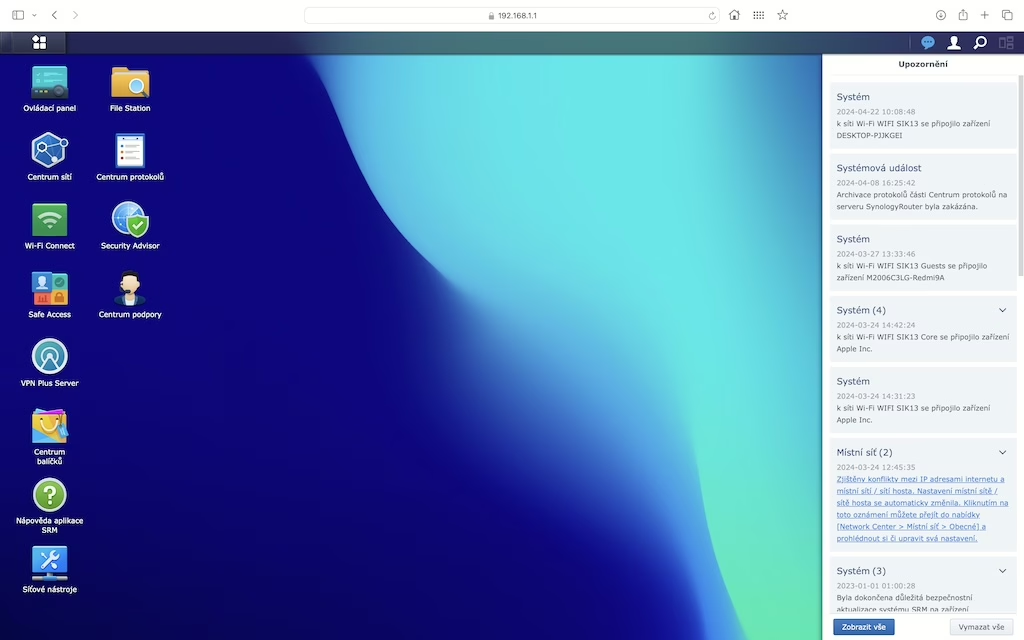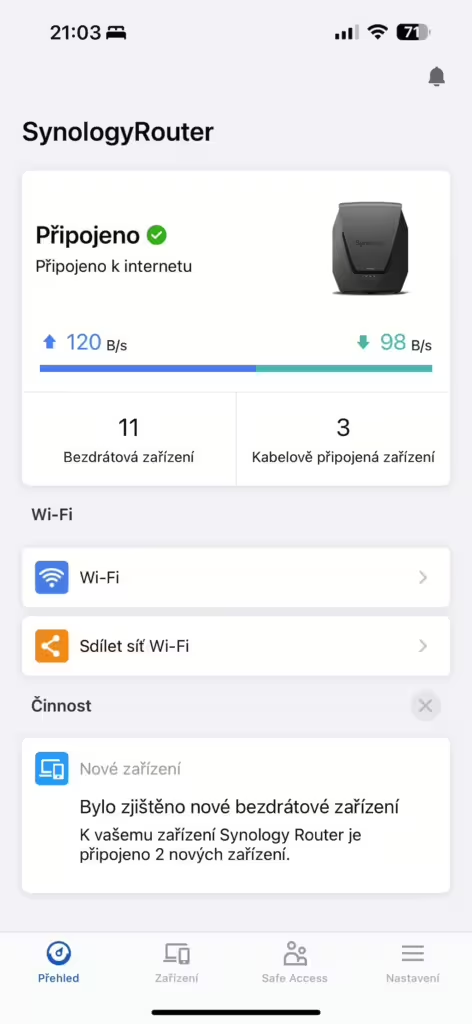Let’s reflect on what life has been like with the Synology WRX560 router after a year of use and recall why we chose it and whether it fulfills the promises made by this traditional network storage manufacturer.

Based on our experience with Synology products, we can say that compared to competing products, Synology’s hardware solutions are not exceptional, but offer a ton of power.
Hardware:
Dual WAN (1GbE WAN Primary + 2.5GbE WAN Secondary/LAN), 3x 1GbE LAN
Wi-Fi 6: IEEE 802.11ax (802.11a/b/g/n/ac/ax, 2.4GHz: 600Mbps, 5GHz: 2400Mbps)
Security: Up to WPA3-Personal/Enterprise, Wi-Fi Enhanced Open (OWE)
USB: 3.2 Gen 1 x 1 (5V, 0.9A power output)
CPU: QUALCOMM Hawkeye IPQ8071A Quad core 1.4 GHz (average load 2.71%)
RAM: 512 MB DDR4 (typically used 60%)
Average power consumption 10.80 W (in operation)
Advantages:
+ Modern design without external antennas (comparable range to external ones)
+ Mesh network that eliminates uncovered spots when using multiple Synology routers
+ If considering Mesh, it is not necessary to buy the same model. For example, the MR2200AC model, at approximately half the price of the WRX560 model, is sufficient for extending coverage to less critical areas (maximum 1 primary + 12 WiFi nodes connected by cable, or 1 primary + 6 WiFi nodes)
+ Smart WAN switches or balances the load between two internet service providers
Synology knows well that the competition is strong in terms of hardware. What we appreciate about Synology is hidden in the power of their software, specifically in the SRM operating system.
SRM is a chapter unto itself and, like DSM for NAS, deserves a separate blog. However, we’ll try to highlight what we’ve enjoyed about SRM over the past year and continue to enjoy:
Software:
+ SRM intuitive interface using a desktop-like environment similar to DSM in the NAS
+ Simplified mobile app for SRM system management
+ Option to log in with two-step verification in the Secure SignIn app
+ Remote and SSL-secured management from anywhere thanks to the Synology.me domain or QuickConnect ID
+ Interaction between DSM and SRM systems for necessary router settings can be done automatically from the DSM system in NAS
+ Configuration of guest networks and other virtual networks (network segmentation, max 5, trunk) and their schedule. Example, the guest network is only active between 8am – 6 pm
+ The ThreatPrevention app helps directly protect network traffic
+ Regular SRM updates throughout the past year
+ The VPN Plus Server app is used for remote access to our network
+ The Safe Access app is used to assign devices in the network to individual users/profiles, e.g., a profile for smart assistants in the home
+ Monitoring specific activities of devices/users on the internet, including visited pages and the duration of these activities (we see this as a privacy intrusion and do not use this feature). However, it is suitable for parents who want to monitor their children, and it is possible to restrict unsuitable content or limit their internet time to selected time windows
+ When connecting an external SSD/HDD via USB, the File Station app can be used to launch file services on the network dedicated to selected users based on their permissions. Here we see that SRM has taken the best from DSM. It can even be connected to a domain/LDAP
+ The Security Advisor app, which we regularly use, comprehensively analyzes the SRM system and recommends steps to secure it. Very useful application.
+ Notifications via email, SMS, or mobile app are very practical
+ The Network Center app provides a great overview of network status and individual port speeds, internet settings, port forwarding, local network including VLAN, control and operation modes, and security
+ The Wi-Fi Connect app allows viewing the current status of Wi-Fi networks, settings, points, and clients and their current Wi-Fi network usage
+ Up to 10 Wi-Fi SSID
+ Other apps: Download Station, DNS Server, Media Server, and RADIUS Server
Screenshots:


During the year-long test, we did not encounter any problems, and the device works flawlessly. Negatives are hard to find in our usage case. Perhaps another 2.5GbE port and the ability to switch to the SRM desktop environment directly from the mobile app, as in the DSM operating system for NAS, for more detailed system settings directly from the mobile phone would be appreciated.
In conclusion, it is highly recommended for home users or small businesses. For more professional or complex deployments, solutions from companies like Ubiquiti might be considered.
More information about Synology routers can be found on the manufacturer’s website.

